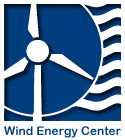Gordon Stewart will speak on "Design Standards for Floating Offshore Wind Turbines".
Abstract: With the push towards siting wind turbines farther offshore due to higher wind quality and less visibility, floating turbine substructures, which can be located in deep water, are becoming an economically attractive option. While the International Electrotechnical Commission’s 61400-3 design standard covers fixed bottom offshore wind turbines, there is no equivalent standard for offshore floating wind turbines. There are a number of new research questions that are necessary to answer to develop a design standard that considers floating wind turbines. These include questions about required simulation length, impact of uncertainty in wind and wave misalignment, and accurate modeling of the hydrodynamics of the floating platform. These research questions will be answered by analyzing large numbers of floating wind turbine simulations using the FAST wind turbine modeling software developed by NREL."
Pam Loring will speak about "Habitat Use of Sea Ducks in Southern New England and Siting of Offshore Wind Energy Facilities".
Abstract: The southern New England continental shelf is an important wintering and migratory staging area for black (Melanitta americana), surf (M. perspicillata) and white-winged (M. fusca) scoters, and has been identified as a priority region for developing offshore renewable energy facilities. However, little is known about the phenology, movements, and habitat use of scoters in this region, and this information is necessary to assess risks to scoters during the marine spatial planning process. In this study, we used survey counts and habitat sampling techniques to compare densities of scoters in relation to benthic habitat characteristics and macroinvertebrate community assemblages at foraging sites in southern New England during the winter of 2010–2011. In addition, we analyzed location data from satellite-tagged black scoters that wintered (2010–2011 and 2011–2012) in southern New England to: estimate migratory timing and length of stay, quantify winter home range size and philopatry between winters, examine key habitat characteristics associated with core-use areas, and map relative probabilities of use across a 3,800 km2 marine spatial planning area for two proposed offshore renewable energy facilities. We found the highest densities of scoters foraging in sand substrates, where infaunal benthic macroinvertebrate communities were largely represented by the taxa Ilyanassa, Phyllodocida, Tellina, and Ensis. Satellite-tagged black scoters in this study spent nearly five months each year in southern New England and their winter home ranges widely varied among individuals. During both winter periods, black scoter core-use areas were closer to shore, at shallower water depths, with coarse-grained sand and higher probability of hard-bottom occurrence relative to available areas. Results from this study indicate that potential interactions exist between black scoters and marine renewable energy development in southern New England. Renewable energy facilities sited in relatively shallow, nearshore habitats over hard-bottomed or coarse-sand substrate may pose the greatest risk of habitat loss to black scoters wintering in this region.
IGERT 06 DEC 2012 Gordie Stewart & Pam Loring from UMass Offshore Wind IGERT on Vimeo.

